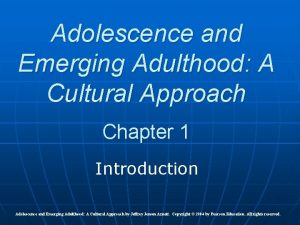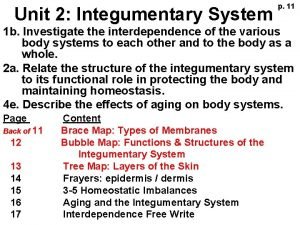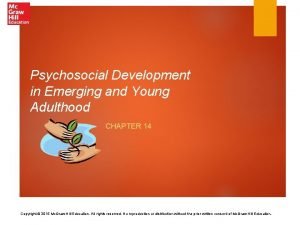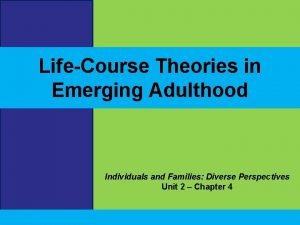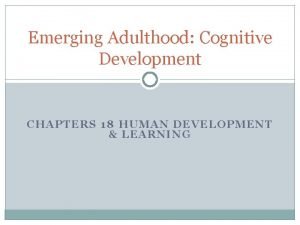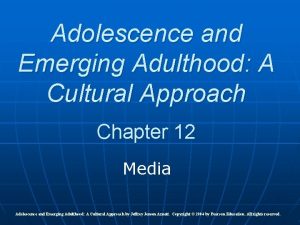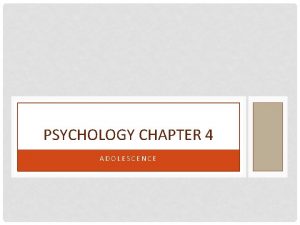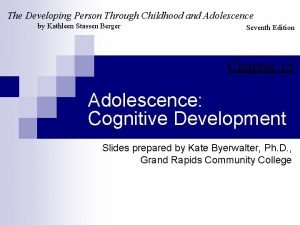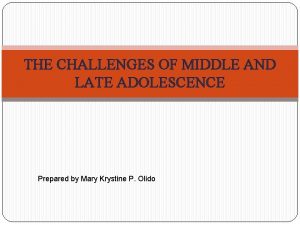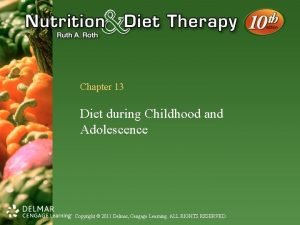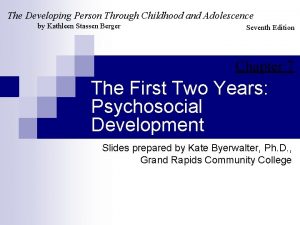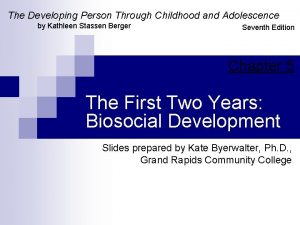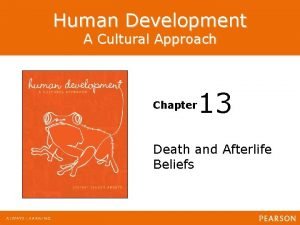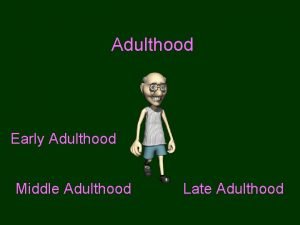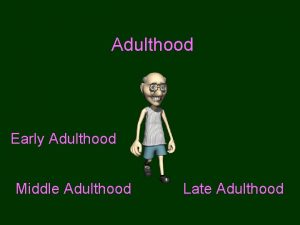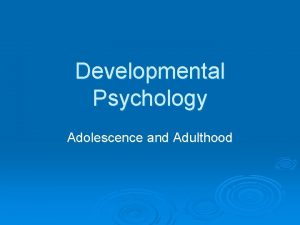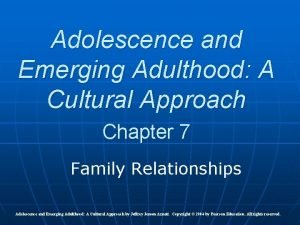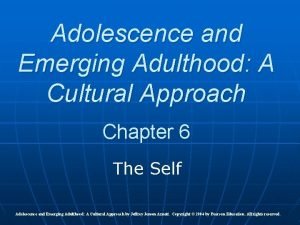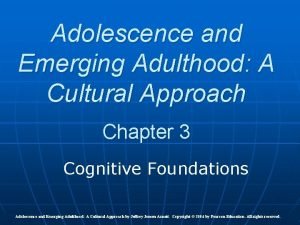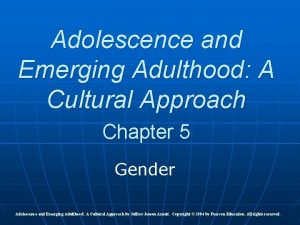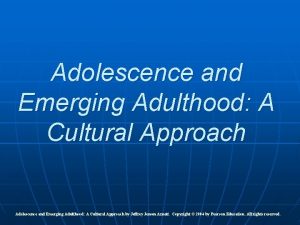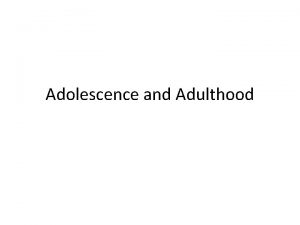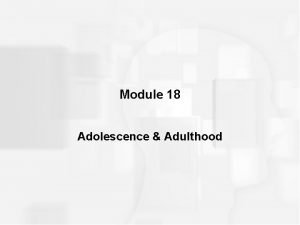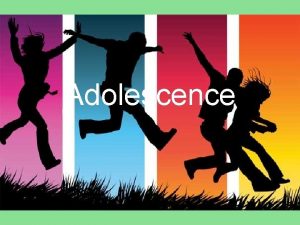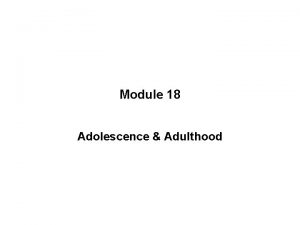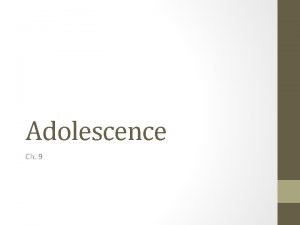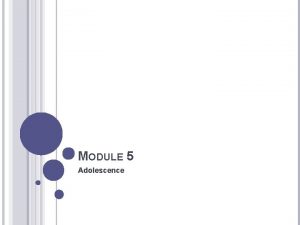Adolescence and Emerging Adulthood A Cultural Approach Chapter





























- Slides: 29

Adolescence and Emerging Adulthood: A Cultural Approach Chapter 11 Work Adolescence and Emerging Adulthood: A Cultural Approach by Jeffrey Jensen Arnett. Copyright © 2004 by Pearson Education. All rights reserved.

Chapter Overview n n n Adolescent work in traditional cultures History of adolescent work in industrialized countries Current trends of adolescent work in industrialized countries Transition from school to work Characteristics of young people who volunteer Adolescence and Emerging Adulthood: A Cultural Approach by Jeffrey Jensen Arnett. Copyright © 2004 by Pearson Education. All rights reserved.

Adolescent Work in Traditional Cultures n Hunting, Fishing and Gathering • These duties are typically undertaken by men • Boys learn to hunt and fish by accompanying their father and other men on expeditions • Often in cultures where males have the responsibility for hunting or fishing, women have a complementary responsibility for gathering An Interesting Aside: Hunting may be required of adolescent boys as a way of showing that they are ready for manhood. Among the nomadic Bushmen of the Kalahari Desert in Africa a boy is not considered a man until he has successfully killed his first antelope. Adolescence and Emerging Adulthood: A Cultural Approach by Jeffrey Jensen Arnett. Copyright © 2004 by Pearson Education. All rights reserved.

Adolescent Work in Traditional Cultures n Farming and Care of Domestic Animals • Adolescents in cultures with economies based on farming and care of domestic animals often provide useful work to their families • Because taking care of domestic animals often requires little in the way of skill or experience, it is a frequent responsibility of adolescents and even pre-adolescents all over the world • Farming often requires a higher level of training and skill so this enterprise if typically carried out by fathers & sons Interesting Footnote: Even today farming remains the main occupation of a substantial proportion of the world’s population. However, in developing countries the proportion of people farming is declining due to industrialization Adolescence and Emerging Adulthood: A Cultural Approach by Jeffrey Jensen Arnett. Copyright © 2004 by Pearson Education. All rights reserved.

Adolescent Work in Traditional Cultures n Child Care and Household Work • Women and girls have the main responsibility in most traditional cultures in caring for children and doing household work • By doing this kind of work, the adolescent daughter prepares herself for her adult work role and demonstrates to potential marriage partners that she is capable of running a household Preparing food is heavily labour intensive in traditional cultures. You cant’ just defrost it in the microwave or pick it up at a drive through window! Adolescence and Emerging Adulthood: A Cultural Approach by Jeffrey Jensen Arnett. Copyright © 2004 by Pearson Education. All rights reserved.

Discussion Detour n n n The Effect of Globalization on Adolescent Work in Traditional Cultures How are work patterns in traditional cultures being influenced by globalization? Think about both positive and negative factors Adolescence and Emerging Adulthood: A Cultural Approach by Jeffrey Jensen Arnett. Copyright © 2004 by Pearson Education. All rights reserved.

Adolescent Work Before 1900 n n In Europe from about 1500 to 1700, it was common for young people to leave their homes to take part in life-cycle service during their late teens and twenties As industrialization proceeded in the 18 th and 19 th centuries, it became common for adolescents to work in factories Children and adolescents who worked in cotton mills were only half as likely to live past age 20 as those outside the mill. Adolescence and Emerging Adulthood: A Cultural Approach by Jeffrey Jensen Arnett. Copyright © 2004 by Pearson Education. All rights reserved.

Adolescent Work in the 20 th Century Age of Adolescence Combining school with part time job 80% of high school seniors worked 1890 -1920 1950 -1970 s 1990 s Trend toward staying in school 2/3 rds of high school seniors worked Beginning in the 1930 s 1980 s Adolescence and Emerging Adulthood: A Cultural Approach by Jeffrey Jensen Arnett. Copyright © 2004 by Pearson Education. All rights reserved.

The Adolescent Workplace n n Most American girls baby-sit as their first job American boys usually do yard work as their first work experience For older adolescents the majority of work is in restaurants or retail sales On average high school: • Sophomores work 15 hours a week • Seniors work 20 hours per week Adolescence and Emerging Adulthood: A Cultural Approach by Jeffrey Jensen Arnett. Copyright © 2004 by Pearson Education. All rights reserved.

Work and Psychological Functioning n Beyond 20 hours per week • Problems become considerably worse n Beyond 10 hours per week • • n Anxiety Depression Sleep per night declines Disruptive to eating and exercise habits Up to 10 hours per week • Not related to any psychological symptoms • Little effect on adolescent development Adolescence and Emerging Adulthood: A Cultural Approach by Jeffrey Jensen Arnett. Copyright © 2004 by Pearson Education. All rights reserved.

Problem Behavior and Work n Adolescents who work are more likely to: • Use alcohol • Smoke cigarettes • Use drugs It is important to note: CORRELATION DOES NOT ASSUME CAUSATION! Scholars disagree on whether working leads to greater substance use or whether this means that adolescents who work already have a tendency toward substance use. Adolescence and Emerging Adulthood: A Cultural Approach by Jeffrey Jensen Arnett. Copyright © 2004 by Pearson Education. All rights reserved.

Occupational Deviance Over 60% of working adolescents had engaged in at least one type of occupational deviance after being employed for 9 months Adolescence and Emerging Adulthood: A Cultural Approach by Jeffrey Jensen Arnett. Copyright © 2004 by Pearson Education. All rights reserved.

Positive Effects of Adolescent Work Percentage of Adolescents Indicating Benefits Girls Boys Responsibility 90. 2 80. 3 Money Management 65. 7 57. 4 Learned Social Skills 87. 7 78. 3 Work Experience Skill Development 43. 4 42. 1 Work Ethic 73. 3 68. 1 Independence 75. 0 77. 7 Time Management 78. 6 74. 5 Learned about life Shaped future 26. 2 29. 0 Adolescence and Emerging Adulthood: A Cultural Approach by Jeffrey Jensen Arnett. Copyright © 2004 by Pearson Education. All rights reserved.

The Forgotten Half n n n This report focused on young Americans who do not attend college Special focus was on the loss of manufacturing jobs that used to provide well-paying jobs for unskilled workers A follow-up report (The Forgotten Half Revisited) published 10 years later in 1998 outlined that the prospects for the forgotten half have become worse Young people who do not attend college are “still in a free-fall of declining earnings and diminished expectations. Adolescence and Emerging Adulthood: A Cultural Approach by Jeffrey Jensen Arnett. Copyright © 2004 by Pearson Education. All rights reserved.

Where the job are and are going to be! Adolescence and Emerging Adulthood: A Cultural Approach by Jeffrey Jensen Arnett. Copyright © 2004 by Pearson Education. All rights reserved.

New Basic Skills Murnane and Levy (1997) concluded that six basic skills are necessary for success at jobs office jobs and factory jobs now available to high school graduates 1. Reading at a ninth-grade level or higher 2. Doing math at a ninth-grade level or higher 3. Solving semi-structured problems 4. Communicating orally and in writing 5. Using a computer for word processing & other tasks 6. Collaborating in diverse groups Close to half of all 17 year olds cannot read or do math at the level needed to succeed at the new jobs A Sobering Picture: n Adolescence and Emerging Adulthood: A Cultural Approach by Jeffrey Jensen Arnett. Copyright © 2004 by Pearson Education. All rights reserved.

Job Corps n n n Began in 1964, this is a job training program for emerging adults in the United States Currently serves 60, 000 new participants aged 16 to 24 each year in low-income areas all over the U. S. The research done on the Job Corps program indicated numerous benefits to participants • • • Employed more hours per week Earned $22 more per week Improved literacy and numeracy skills More likely to earn a GED Less likely to be arrested Adolescence and Emerging Adulthood: A Cultural Approach by Jeffrey Jensen Arnett. Copyright © 2004 by Pearson Education. All rights reserved.

Europe vs. the United States n n In European countries, school-to-work programs are a basic part of the national government In the U. S. there is not a political consensus about the value of such programs One Man’s Opinion Head of IBM – Louis Gerstner What’s your opinion? We are not interested in public schools teaching work-related skills What’s killing us is having to teach new hires to read, compute, communicate, and think Adolescence and Emerging Adulthood: A Cultural Approach by Jeffrey Jensen Arnett. Copyright © 2004 by Pearson Education. All rights reserved.

Apprenticeship in Western Europe n n n Apprenticeship is where an adolescent “novice” serves under contract to a “master” who has substantial experience in a profession The German example: 60% of all 16 to 18 year olds are in an apprenticeship program Common features of apprenticeship programs are: • • • Entry at age 16 Apprenticeship lasting 2 to 3 years Continued part-time schooling while apprenticing School curriculum closely connected with training Training that takes place in the workplace Preparation for a career in a respected profession that provides an adequate income Adolescence and Emerging Adulthood: A Cultural Approach by Jeffrey Jensen Arnett. Copyright © 2004 by Pearson Education. All rights reserved.

Development of Occupational Goals n Donald Super’s (1967, 1976, 1980, 1992) theory of the development of occupational goals begins with adolescence and continues through five stages into adulthood as follows: 1. Crystallization (age 14 to 18) 2. Specification (age 18 to 21) 3. Implementation (age 21 to 24) 4. Stabilization (age 25 to 35) 5. Consolidation (age 35 and up) Discussion Detour: Why doesn’t everyone fit the pattern? Adolescence and Emerging Adulthood: A Cultural Approach by Jeffrey Jensen Arnett. Copyright © 2004 by Pearson Education. All rights reserved.

Influences on Occupational Goals n n Personality Characteristics • People seek occupations that they judge to be consistent with their interests and talents Gender • Gender has a substantial influence on job choice Discussion Detour: Why do gender differences in job choice persist despite the fact that women now exceed men in terms of overall educational attainment? Adolescence and Emerging Adulthood: A Cultural Approach by Jeffrey Jensen Arnett. Copyright © 2004 by Pearson Education. All rights reserved.

Holland’s Theory of Personality Categories n Consider these categories when matching a person with a prospective occupation Category Examples of Jobs Realistic Construction, farming Intellectual Math and science Social Teaching, social work Conventional Bank teller, secretary Enterprising Sales, running a business Artistic Painting, writing fiction Adolescence and Emerging Adulthood: A Cultural Approach by Jeffrey Jensen Arnett. Copyright © 2004 by Pearson Education. All rights reserved.

Discussion Stop n n n Using Holland’s six personality categories what personality type do you think you are? Does this type fit with your career aspirations? How not? Adolescence and Emerging Adulthood: A Cultural Approach by Jeffrey Jensen Arnett. Copyright © 2004 by Pearson Education. All rights reserved.

Work in Emerging Adulthood n n Unlike adolescents, most emerging adults are looking for a job that will turn into a career In the course of emerging adulthood they may try 7 or 8 different jobs between the ages of 18 and 30 What do I really want to do? What am I best at? What do I enjoy the most? How do my abilities and desires fit in with the kinds of opportunities that are available to me? Adolescence and Emerging Adulthood: A Cultural Approach by Jeffrey Jensen Arnett. Copyright © 2004 by Pearson Education. All rights reserved.

Unemployment n n n Refers only to people who are not in school, are not working and are looking for a job In both Europe and the United States, the unemployment rate for emerging adults is at least twice as high as for adults beyond age 25 The days are gone in the United States when stable, high-paying jobs were plentiful in settings such as automobile factories and steel mills Adolescence and Emerging Adulthood: A Cultural Approach by Jeffrey Jensen Arnett. Copyright © 2004 by Pearson Education. All rights reserved.

Unemployment What explains the high rates of unemployment among minority groups? Adolescence and Emerging Adulthood: A Cultural Approach by Jeffrey Jensen Arnett. Copyright © 2004 by Pearson Education. All rights reserved.

What can be done? n Upgrade education • Financial support for schools should be more centralized and more equal n Improve school-to-work programs • Young people in urban areas are especially harmed by the lack of effective programs n Improve access to employment • Most new jobs are opening up in suburban areas, young people in inner cities because public transportation is inadequate and few of them have access to a car n Provide government-funded public service jobs • Having young people serve in jobs such as nurse’s aid or bridge painters would give them useful work experience and enhance the quality of life in the areas they live Adolescence and Emerging Adulthood: A Cultural Approach by Jeffrey Jensen Arnett. Copyright © 2004 by Pearson Education. All rights reserved.

Community Service in Adolescence n Adolescents who volunteer tend to have • • • a high sense of personal competence higher educational goals high ideals a greater desire to help others a greater sense of social responsibility parents who also volunteer Long term effects of volunteering: People who take part in volunteer work in adolescence are more likely to be active in political activities and volunteer organizations as adults Adolescence and Emerging Adulthood: A Cultural Approach by Jeffrey Jensen Arnett. Copyright © 2004 by Pearson Education. All rights reserved.

Community Service in Emerging Adulthood n Peace Corps • An organization that send American volunteers around the world to assist people in other nations by providing knowledge and skills in areas such as medical care, housing, sanitation and food production n n Military Service • Since the early 1970 s military service has been voluntary • Those who volunteer tend to come from low-SES families and low college aspirations • African Americans and Latinos are more likely than Whites to enlist Americorps • Does not originate volunteer programs but instead sponsors volunteers to work in local community organizations doing such work as tutoring, helping persons with disabilities, and working with elderly persons Adolescence and Emerging Adulthood: A Cultural Approach by Jeffrey Jensen Arnett. Copyright © 2004 by Pearson Education. All rights reserved.
 Jeffrey arnett emerging adulthood theory
Jeffrey arnett emerging adulthood theory Infancy childhood adolescence adulthood old age
Infancy childhood adolescence adulthood old age Emerging adulthood psychosocial development
Emerging adulthood psychosocial development Jeffrey arnett emerging adulthood theory
Jeffrey arnett emerging adulthood theory Cognitive development in emerging adulthood
Cognitive development in emerging adulthood Jeffrey arnett emerging adulthood theory
Jeffrey arnett emerging adulthood theory Chapter 4 adolescence psychology
Chapter 4 adolescence psychology Chapter 4 adolescence psychology
Chapter 4 adolescence psychology Byzantine empire 1300
Byzantine empire 1300 Chapter 5 it infrastructure and emerging technologies
Chapter 5 it infrastructure and emerging technologies Chapter 5 it infrastructure and emerging technologies
Chapter 5 it infrastructure and emerging technologies Chapter 5 it infrastructure and emerging technologies
Chapter 5 it infrastructure and emerging technologies Contcloud
Contcloud It infrastructure and emerging technologies
It infrastructure and emerging technologies Emerging technology chapter 4
Emerging technology chapter 4 Chapter 22 life in the emerging urban society
Chapter 22 life in the emerging urban society Difference between datagram and virtual circuit approach
Difference between datagram and virtual circuit approach Tony wagner's seven survival skills
Tony wagner's seven survival skills Adolescent egocentrism
Adolescent egocentrism Centration
Centration 3 filipino adolescent heroes
3 filipino adolescent heroes Eating a balanced diet during childhood and adolescence
Eating a balanced diet during childhood and adolescence The developing person through childhood and adolescence
The developing person through childhood and adolescence Principles of growth and development
Principles of growth and development The developing person through childhood and adolescence
The developing person through childhood and adolescence The cultural approach
The cultural approach A cultural approach to understanding mass communication
A cultural approach to understanding mass communication A cultural approach to media recognizes
A cultural approach to media recognizes Whole school approach to cultural diversity
Whole school approach to cultural diversity Human development a cultural approach
Human development a cultural approach
